Toyota's Logistics Strategy Analysis
VerifiedAdded on 2020/04/21
|10
|2535
|115
AI Summary
The assignment delves into Toyota's comprehensive logistics strategy, examining key aspects such as transportation modes, the application of Incoterms for international trade, and the company's commitment to sustainable practices. A crucial element is the analysis of Toyota's reliance on third-party logistics providers (3PL) and the vital long-term relationships they cultivate with these partners.
Contribute Materials
Your contribution can guide someone’s learning journey. Share your
documents today.
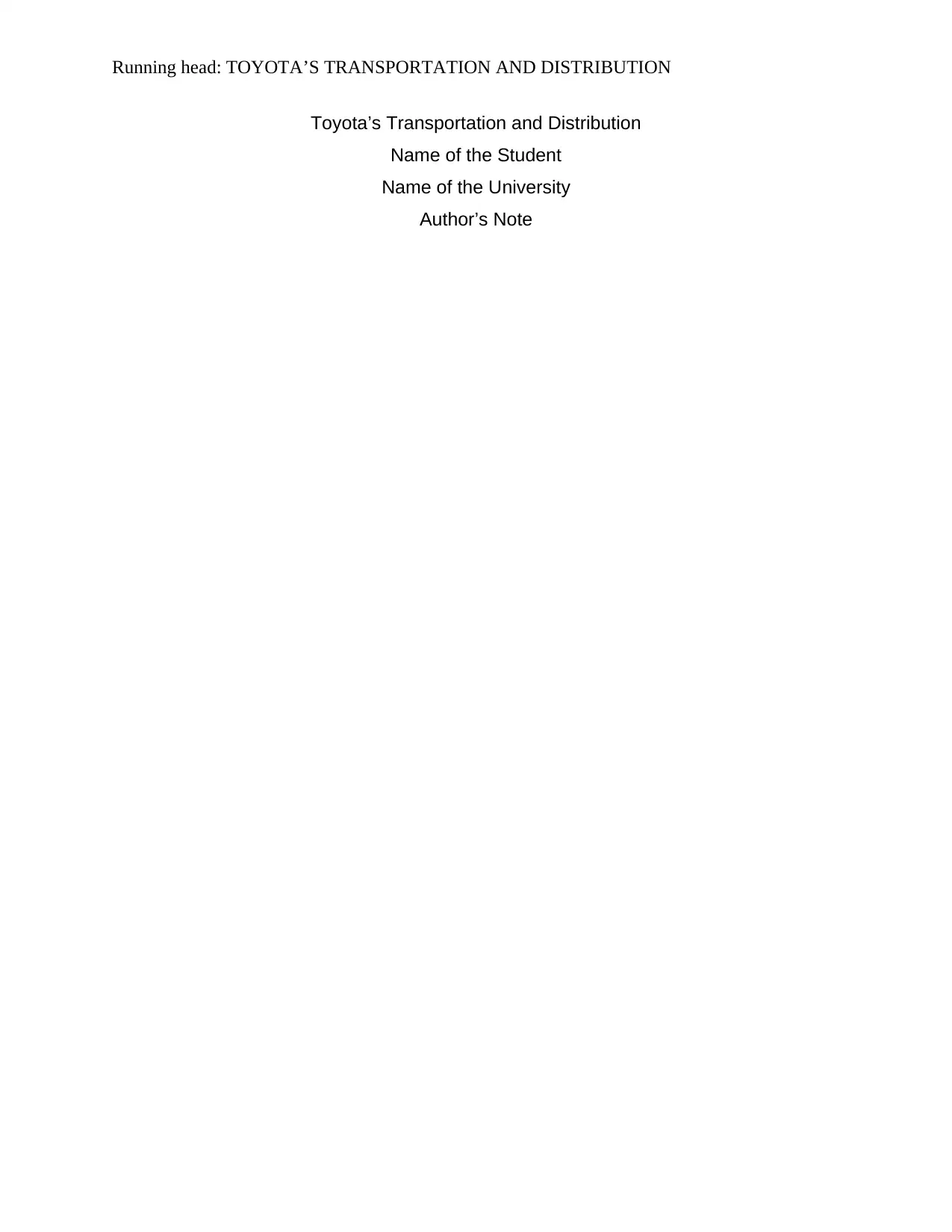
Running head: TOYOTA’S TRANSPORTATION AND DISTRIBUTION
Toyota’s Transportation and Distribution
Name of the Student
Name of the University
Author’s Note
Toyota’s Transportation and Distribution
Name of the Student
Name of the University
Author’s Note
Secure Best Marks with AI Grader
Need help grading? Try our AI Grader for instant feedback on your assignments.
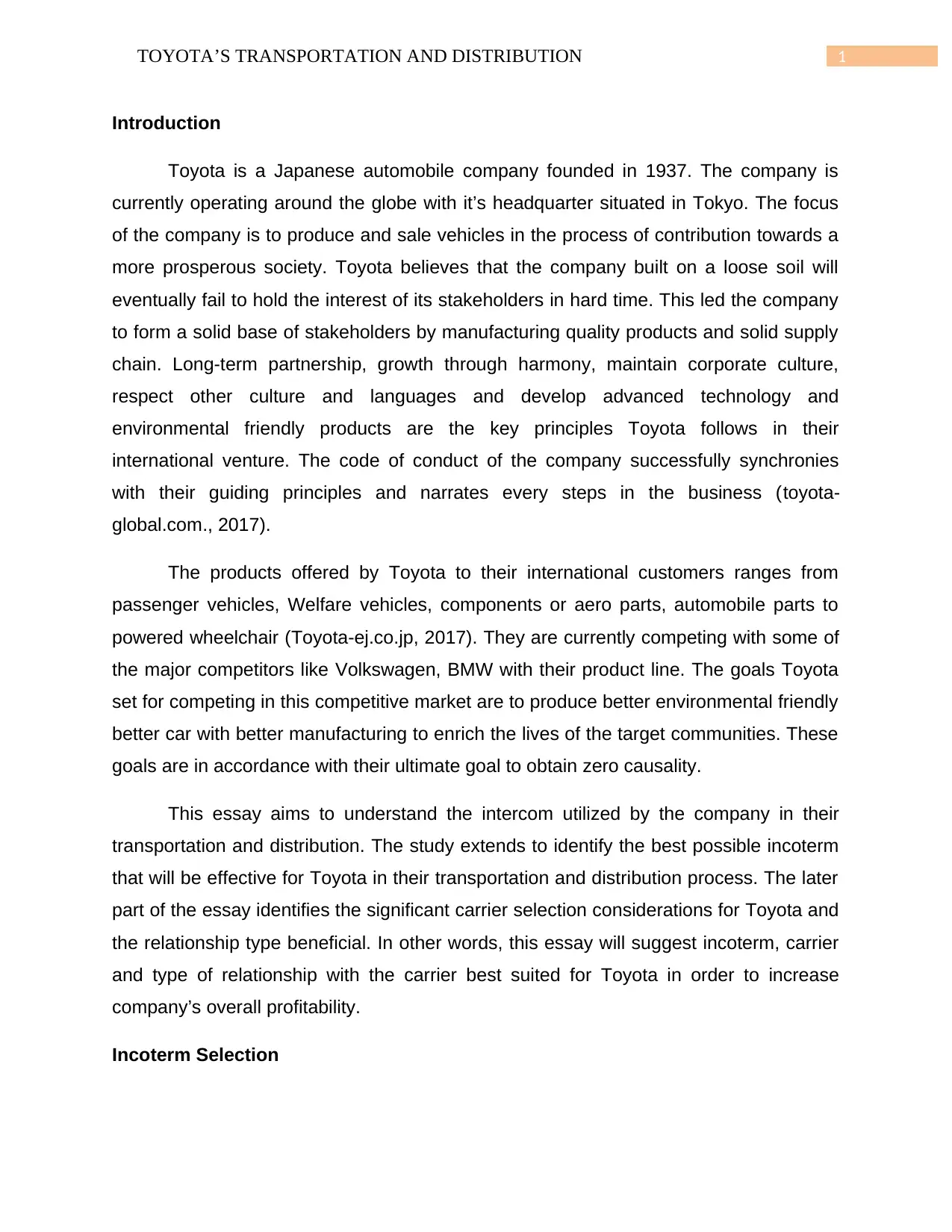
1TOYOTA’S TRANSPORTATION AND DISTRIBUTION
Introduction
Toyota is a Japanese automobile company founded in 1937. The company is
currently operating around the globe with it’s headquarter situated in Tokyo. The focus
of the company is to produce and sale vehicles in the process of contribution towards a
more prosperous society. Toyota believes that the company built on a loose soil will
eventually fail to hold the interest of its stakeholders in hard time. This led the company
to form a solid base of stakeholders by manufacturing quality products and solid supply
chain. Long-term partnership, growth through harmony, maintain corporate culture,
respect other culture and languages and develop advanced technology and
environmental friendly products are the key principles Toyota follows in their
international venture. The code of conduct of the company successfully synchronies
with their guiding principles and narrates every steps in the business (toyota-
global.com., 2017).
The products offered by Toyota to their international customers ranges from
passenger vehicles, Welfare vehicles, components or aero parts, automobile parts to
powered wheelchair (Toyota-ej.co.jp, 2017). They are currently competing with some of
the major competitors like Volkswagen, BMW with their product line. The goals Toyota
set for competing in this competitive market are to produce better environmental friendly
better car with better manufacturing to enrich the lives of the target communities. These
goals are in accordance with their ultimate goal to obtain zero causality.
This essay aims to understand the intercom utilized by the company in their
transportation and distribution. The study extends to identify the best possible incoterm
that will be effective for Toyota in their transportation and distribution process. The later
part of the essay identifies the significant carrier selection considerations for Toyota and
the relationship type beneficial. In other words, this essay will suggest incoterm, carrier
and type of relationship with the carrier best suited for Toyota in order to increase
company’s overall profitability.
Incoterm Selection
Introduction
Toyota is a Japanese automobile company founded in 1937. The company is
currently operating around the globe with it’s headquarter situated in Tokyo. The focus
of the company is to produce and sale vehicles in the process of contribution towards a
more prosperous society. Toyota believes that the company built on a loose soil will
eventually fail to hold the interest of its stakeholders in hard time. This led the company
to form a solid base of stakeholders by manufacturing quality products and solid supply
chain. Long-term partnership, growth through harmony, maintain corporate culture,
respect other culture and languages and develop advanced technology and
environmental friendly products are the key principles Toyota follows in their
international venture. The code of conduct of the company successfully synchronies
with their guiding principles and narrates every steps in the business (toyota-
global.com., 2017).
The products offered by Toyota to their international customers ranges from
passenger vehicles, Welfare vehicles, components or aero parts, automobile parts to
powered wheelchair (Toyota-ej.co.jp, 2017). They are currently competing with some of
the major competitors like Volkswagen, BMW with their product line. The goals Toyota
set for competing in this competitive market are to produce better environmental friendly
better car with better manufacturing to enrich the lives of the target communities. These
goals are in accordance with their ultimate goal to obtain zero causality.
This essay aims to understand the intercom utilized by the company in their
transportation and distribution. The study extends to identify the best possible incoterm
that will be effective for Toyota in their transportation and distribution process. The later
part of the essay identifies the significant carrier selection considerations for Toyota and
the relationship type beneficial. In other words, this essay will suggest incoterm, carrier
and type of relationship with the carrier best suited for Toyota in order to increase
company’s overall profitability.
Incoterm Selection
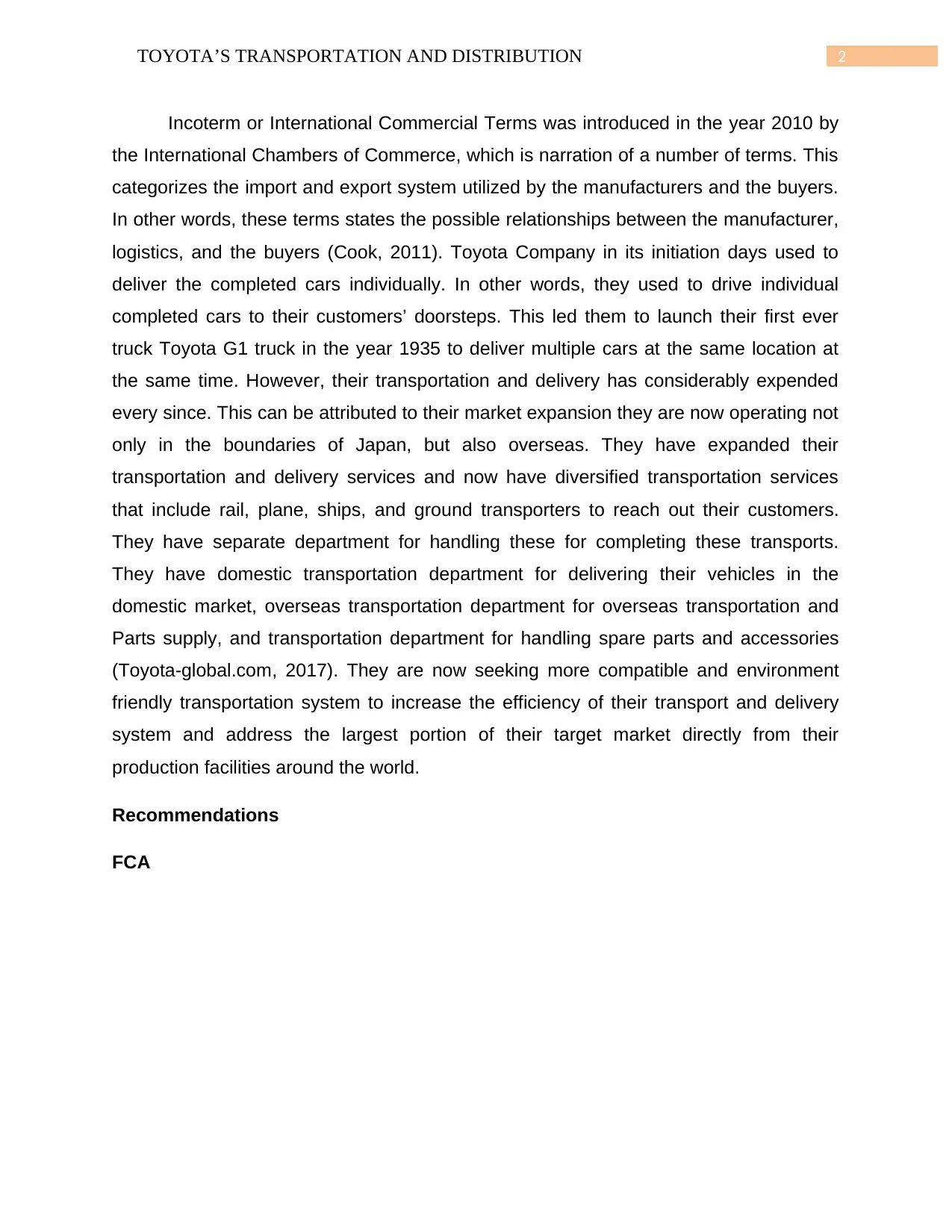
2TOYOTA’S TRANSPORTATION AND DISTRIBUTION
Incoterm or International Commercial Terms was introduced in the year 2010 by
the International Chambers of Commerce, which is narration of a number of terms. This
categorizes the import and export system utilized by the manufacturers and the buyers.
In other words, these terms states the possible relationships between the manufacturer,
logistics, and the buyers (Cook, 2011). Toyota Company in its initiation days used to
deliver the completed cars individually. In other words, they used to drive individual
completed cars to their customers’ doorsteps. This led them to launch their first ever
truck Toyota G1 truck in the year 1935 to deliver multiple cars at the same location at
the same time. However, their transportation and delivery has considerably expended
every since. This can be attributed to their market expansion they are now operating not
only in the boundaries of Japan, but also overseas. They have expanded their
transportation and delivery services and now have diversified transportation services
that include rail, plane, ships, and ground transporters to reach out their customers.
They have separate department for handling these for completing these transports.
They have domestic transportation department for delivering their vehicles in the
domestic market, overseas transportation department for overseas transportation and
Parts supply, and transportation department for handling spare parts and accessories
(Toyota-global.com, 2017). They are now seeking more compatible and environment
friendly transportation system to increase the efficiency of their transport and delivery
system and address the largest portion of their target market directly from their
production facilities around the world.
Recommendations
FCA
Incoterm or International Commercial Terms was introduced in the year 2010 by
the International Chambers of Commerce, which is narration of a number of terms. This
categorizes the import and export system utilized by the manufacturers and the buyers.
In other words, these terms states the possible relationships between the manufacturer,
logistics, and the buyers (Cook, 2011). Toyota Company in its initiation days used to
deliver the completed cars individually. In other words, they used to drive individual
completed cars to their customers’ doorsteps. This led them to launch their first ever
truck Toyota G1 truck in the year 1935 to deliver multiple cars at the same location at
the same time. However, their transportation and delivery has considerably expended
every since. This can be attributed to their market expansion they are now operating not
only in the boundaries of Japan, but also overseas. They have expanded their
transportation and delivery services and now have diversified transportation services
that include rail, plane, ships, and ground transporters to reach out their customers.
They have separate department for handling these for completing these transports.
They have domestic transportation department for delivering their vehicles in the
domestic market, overseas transportation department for overseas transportation and
Parts supply, and transportation department for handling spare parts and accessories
(Toyota-global.com, 2017). They are now seeking more compatible and environment
friendly transportation system to increase the efficiency of their transport and delivery
system and address the largest portion of their target market directly from their
production facilities around the world.
Recommendations
FCA
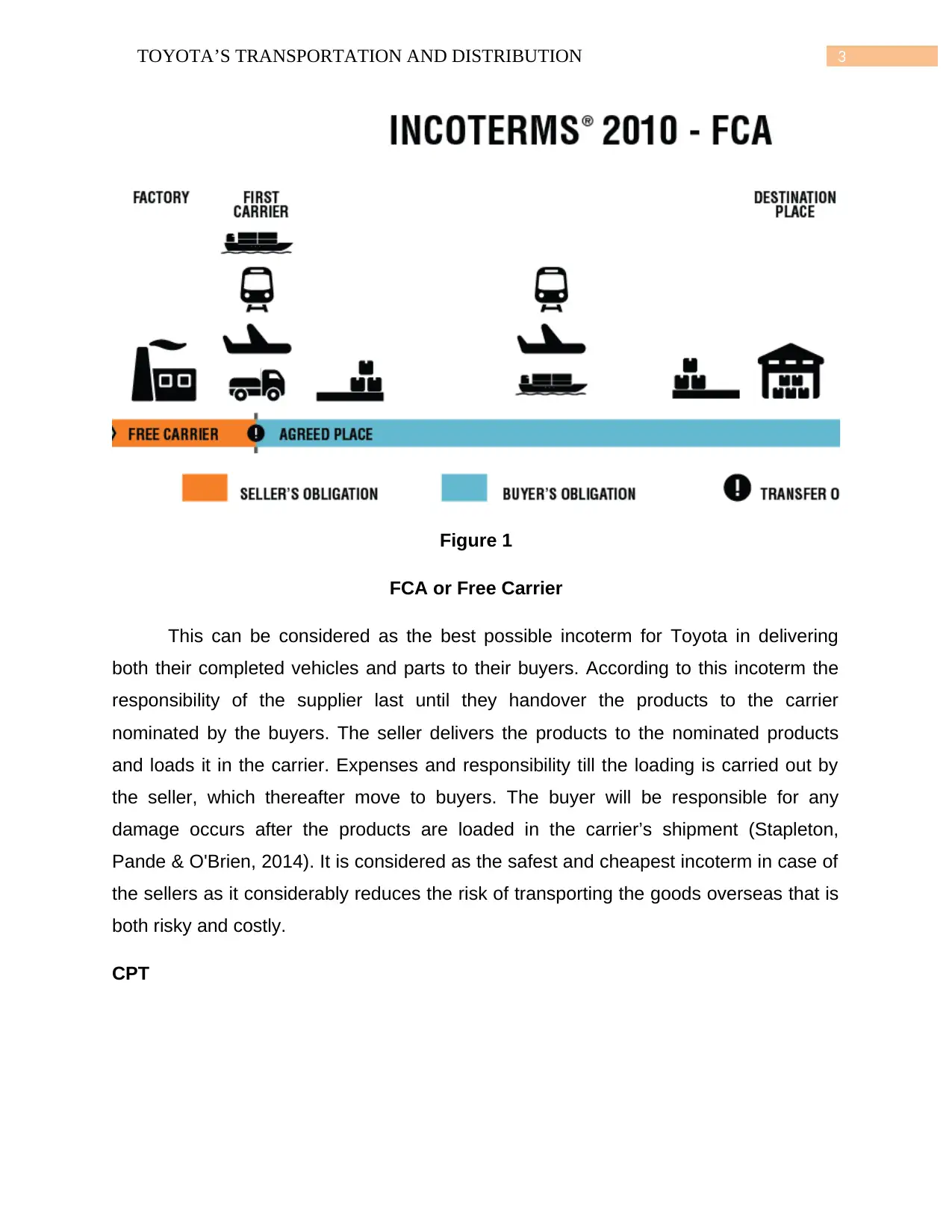
3TOYOTA’S TRANSPORTATION AND DISTRIBUTION
Figure 1
FCA or Free Carrier
This can be considered as the best possible incoterm for Toyota in delivering
both their completed vehicles and parts to their buyers. According to this incoterm the
responsibility of the supplier last until they handover the products to the carrier
nominated by the buyers. The seller delivers the products to the nominated products
and loads it in the carrier. Expenses and responsibility till the loading is carried out by
the seller, which thereafter move to buyers. The buyer will be responsible for any
damage occurs after the products are loaded in the carrier’s shipment (Stapleton,
Pande & O'Brien, 2014). It is considered as the safest and cheapest incoterm in case of
the sellers as it considerably reduces the risk of transporting the goods overseas that is
both risky and costly.
CPT
Figure 1
FCA or Free Carrier
This can be considered as the best possible incoterm for Toyota in delivering
both their completed vehicles and parts to their buyers. According to this incoterm the
responsibility of the supplier last until they handover the products to the carrier
nominated by the buyers. The seller delivers the products to the nominated products
and loads it in the carrier. Expenses and responsibility till the loading is carried out by
the seller, which thereafter move to buyers. The buyer will be responsible for any
damage occurs after the products are loaded in the carrier’s shipment (Stapleton,
Pande & O'Brien, 2014). It is considered as the safest and cheapest incoterm in case of
the sellers as it considerably reduces the risk of transporting the goods overseas that is
both risky and costly.
CPT
Secure Best Marks with AI Grader
Need help grading? Try our AI Grader for instant feedback on your assignments.
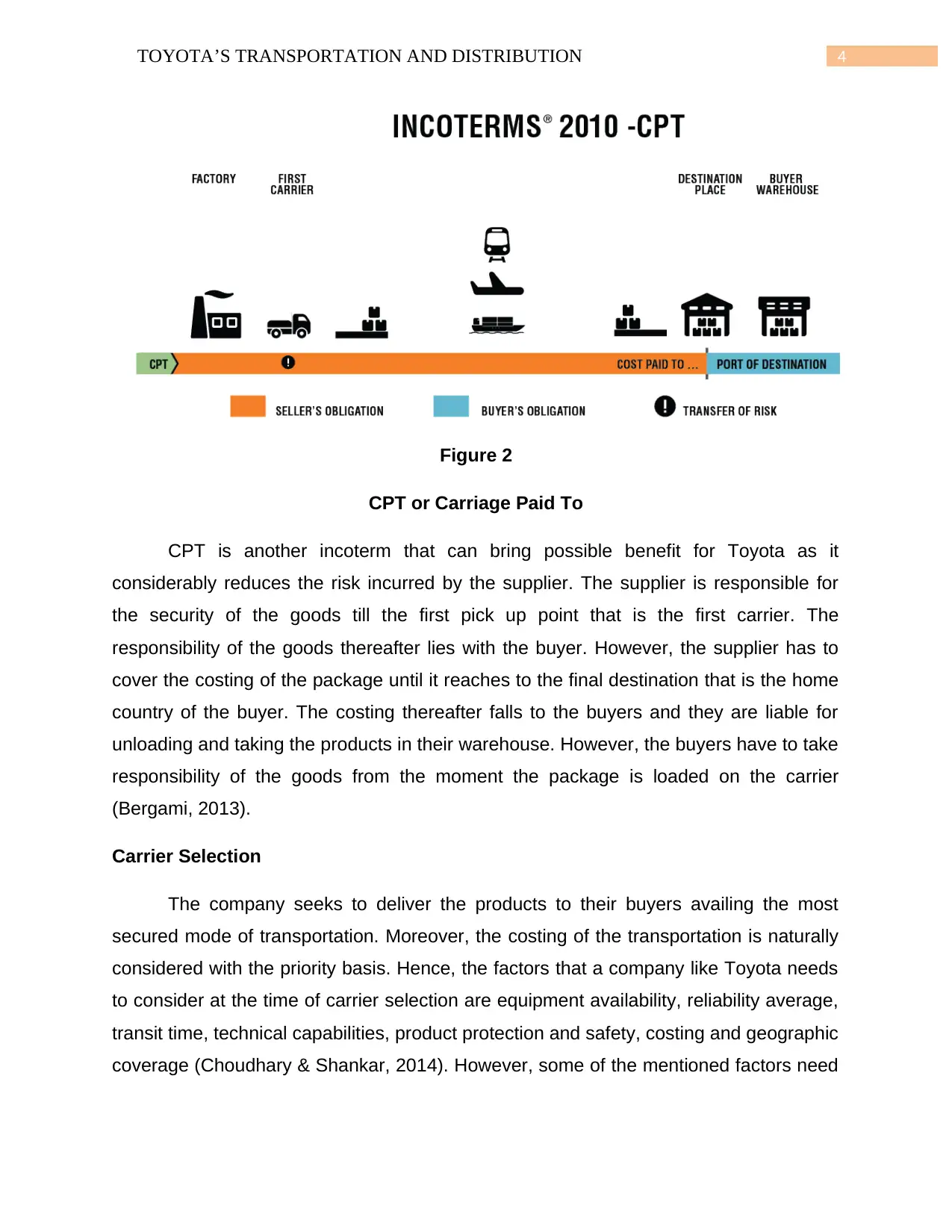
4TOYOTA’S TRANSPORTATION AND DISTRIBUTION
Figure 2
CPT or Carriage Paid To
CPT is another incoterm that can bring possible benefit for Toyota as it
considerably reduces the risk incurred by the supplier. The supplier is responsible for
the security of the goods till the first pick up point that is the first carrier. The
responsibility of the goods thereafter lies with the buyer. However, the supplier has to
cover the costing of the package until it reaches to the final destination that is the home
country of the buyer. The costing thereafter falls to the buyers and they are liable for
unloading and taking the products in their warehouse. However, the buyers have to take
responsibility of the goods from the moment the package is loaded on the carrier
(Bergami, 2013).
Carrier Selection
The company seeks to deliver the products to their buyers availing the most
secured mode of transportation. Moreover, the costing of the transportation is naturally
considered with the priority basis. Hence, the factors that a company like Toyota needs
to consider at the time of carrier selection are equipment availability, reliability average,
transit time, technical capabilities, product protection and safety, costing and geographic
coverage (Choudhary & Shankar, 2014). However, some of the mentioned factors need
Figure 2
CPT or Carriage Paid To
CPT is another incoterm that can bring possible benefit for Toyota as it
considerably reduces the risk incurred by the supplier. The supplier is responsible for
the security of the goods till the first pick up point that is the first carrier. The
responsibility of the goods thereafter lies with the buyer. However, the supplier has to
cover the costing of the package until it reaches to the final destination that is the home
country of the buyer. The costing thereafter falls to the buyers and they are liable for
unloading and taking the products in their warehouse. However, the buyers have to take
responsibility of the goods from the moment the package is loaded on the carrier
(Bergami, 2013).
Carrier Selection
The company seeks to deliver the products to their buyers availing the most
secured mode of transportation. Moreover, the costing of the transportation is naturally
considered with the priority basis. Hence, the factors that a company like Toyota needs
to consider at the time of carrier selection are equipment availability, reliability average,
transit time, technical capabilities, product protection and safety, costing and geographic
coverage (Choudhary & Shankar, 2014). However, some of the mentioned factors need
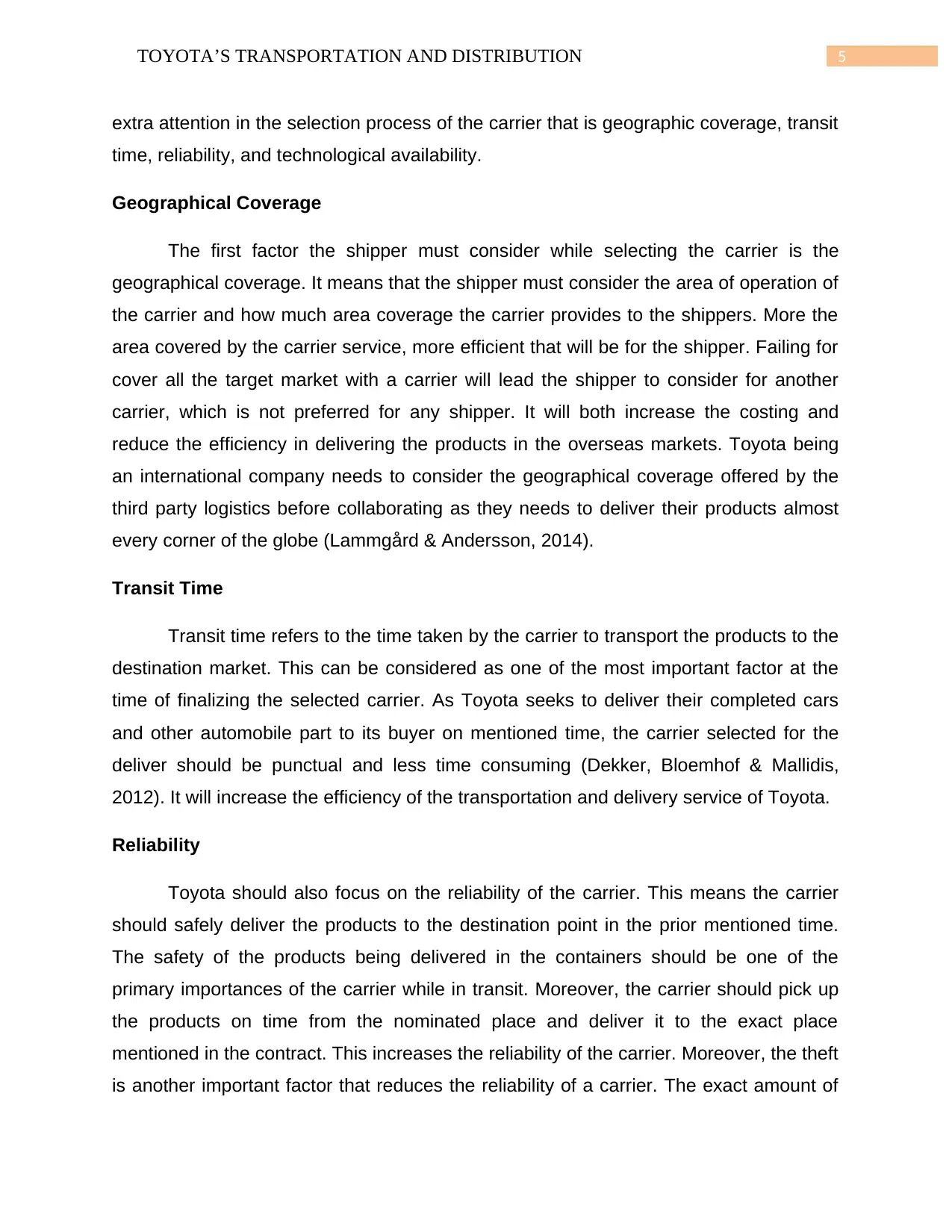
5TOYOTA’S TRANSPORTATION AND DISTRIBUTION
extra attention in the selection process of the carrier that is geographic coverage, transit
time, reliability, and technological availability.
Geographical Coverage
The first factor the shipper must consider while selecting the carrier is the
geographical coverage. It means that the shipper must consider the area of operation of
the carrier and how much area coverage the carrier provides to the shippers. More the
area covered by the carrier service, more efficient that will be for the shipper. Failing for
cover all the target market with a carrier will lead the shipper to consider for another
carrier, which is not preferred for any shipper. It will both increase the costing and
reduce the efficiency in delivering the products in the overseas markets. Toyota being
an international company needs to consider the geographical coverage offered by the
third party logistics before collaborating as they needs to deliver their products almost
every corner of the globe (Lammgård & Andersson, 2014).
Transit Time
Transit time refers to the time taken by the carrier to transport the products to the
destination market. This can be considered as one of the most important factor at the
time of finalizing the selected carrier. As Toyota seeks to deliver their completed cars
and other automobile part to its buyer on mentioned time, the carrier selected for the
deliver should be punctual and less time consuming (Dekker, Bloemhof & Mallidis,
2012). It will increase the efficiency of the transportation and delivery service of Toyota.
Reliability
Toyota should also focus on the reliability of the carrier. This means the carrier
should safely deliver the products to the destination point in the prior mentioned time.
The safety of the products being delivered in the containers should be one of the
primary importances of the carrier while in transit. Moreover, the carrier should pick up
the products on time from the nominated place and deliver it to the exact place
mentioned in the contract. This increases the reliability of the carrier. Moreover, the theft
is another important factor that reduces the reliability of a carrier. The exact amount of
extra attention in the selection process of the carrier that is geographic coverage, transit
time, reliability, and technological availability.
Geographical Coverage
The first factor the shipper must consider while selecting the carrier is the
geographical coverage. It means that the shipper must consider the area of operation of
the carrier and how much area coverage the carrier provides to the shippers. More the
area covered by the carrier service, more efficient that will be for the shipper. Failing for
cover all the target market with a carrier will lead the shipper to consider for another
carrier, which is not preferred for any shipper. It will both increase the costing and
reduce the efficiency in delivering the products in the overseas markets. Toyota being
an international company needs to consider the geographical coverage offered by the
third party logistics before collaborating as they needs to deliver their products almost
every corner of the globe (Lammgård & Andersson, 2014).
Transit Time
Transit time refers to the time taken by the carrier to transport the products to the
destination market. This can be considered as one of the most important factor at the
time of finalizing the selected carrier. As Toyota seeks to deliver their completed cars
and other automobile part to its buyer on mentioned time, the carrier selected for the
deliver should be punctual and less time consuming (Dekker, Bloemhof & Mallidis,
2012). It will increase the efficiency of the transportation and delivery service of Toyota.
Reliability
Toyota should also focus on the reliability of the carrier. This means the carrier
should safely deliver the products to the destination point in the prior mentioned time.
The safety of the products being delivered in the containers should be one of the
primary importances of the carrier while in transit. Moreover, the carrier should pick up
the products on time from the nominated place and deliver it to the exact place
mentioned in the contract. This increases the reliability of the carrier. Moreover, the theft
is another important factor that reduces the reliability of a carrier. The exact amount of
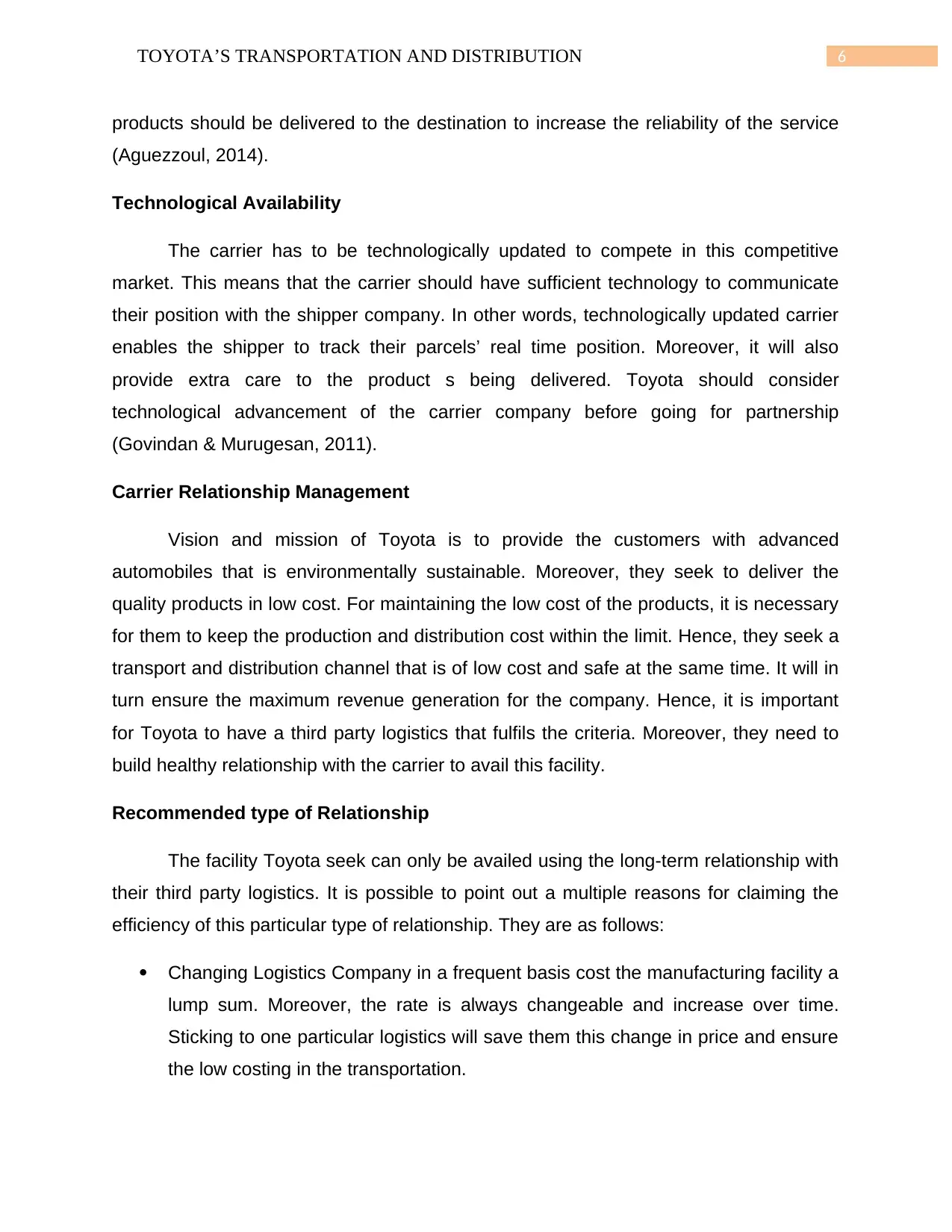
6TOYOTA’S TRANSPORTATION AND DISTRIBUTION
products should be delivered to the destination to increase the reliability of the service
(Aguezzoul, 2014).
Technological Availability
The carrier has to be technologically updated to compete in this competitive
market. This means that the carrier should have sufficient technology to communicate
their position with the shipper company. In other words, technologically updated carrier
enables the shipper to track their parcels’ real time position. Moreover, it will also
provide extra care to the product s being delivered. Toyota should consider
technological advancement of the carrier company before going for partnership
(Govindan & Murugesan, 2011).
Carrier Relationship Management
Vision and mission of Toyota is to provide the customers with advanced
automobiles that is environmentally sustainable. Moreover, they seek to deliver the
quality products in low cost. For maintaining the low cost of the products, it is necessary
for them to keep the production and distribution cost within the limit. Hence, they seek a
transport and distribution channel that is of low cost and safe at the same time. It will in
turn ensure the maximum revenue generation for the company. Hence, it is important
for Toyota to have a third party logistics that fulfils the criteria. Moreover, they need to
build healthy relationship with the carrier to avail this facility.
Recommended type of Relationship
The facility Toyota seek can only be availed using the long-term relationship with
their third party logistics. It is possible to point out a multiple reasons for claiming the
efficiency of this particular type of relationship. They are as follows:
Changing Logistics Company in a frequent basis cost the manufacturing facility a
lump sum. Moreover, the rate is always changeable and increase over time.
Sticking to one particular logistics will save them this change in price and ensure
the low costing in the transportation.
products should be delivered to the destination to increase the reliability of the service
(Aguezzoul, 2014).
Technological Availability
The carrier has to be technologically updated to compete in this competitive
market. This means that the carrier should have sufficient technology to communicate
their position with the shipper company. In other words, technologically updated carrier
enables the shipper to track their parcels’ real time position. Moreover, it will also
provide extra care to the product s being delivered. Toyota should consider
technological advancement of the carrier company before going for partnership
(Govindan & Murugesan, 2011).
Carrier Relationship Management
Vision and mission of Toyota is to provide the customers with advanced
automobiles that is environmentally sustainable. Moreover, they seek to deliver the
quality products in low cost. For maintaining the low cost of the products, it is necessary
for them to keep the production and distribution cost within the limit. Hence, they seek a
transport and distribution channel that is of low cost and safe at the same time. It will in
turn ensure the maximum revenue generation for the company. Hence, it is important
for Toyota to have a third party logistics that fulfils the criteria. Moreover, they need to
build healthy relationship with the carrier to avail this facility.
Recommended type of Relationship
The facility Toyota seek can only be availed using the long-term relationship with
their third party logistics. It is possible to point out a multiple reasons for claiming the
efficiency of this particular type of relationship. They are as follows:
Changing Logistics Company in a frequent basis cost the manufacturing facility a
lump sum. Moreover, the rate is always changeable and increase over time.
Sticking to one particular logistics will save them this change in price and ensure
the low costing in the transportation.
Paraphrase This Document
Need a fresh take? Get an instant paraphrase of this document with our AI Paraphraser
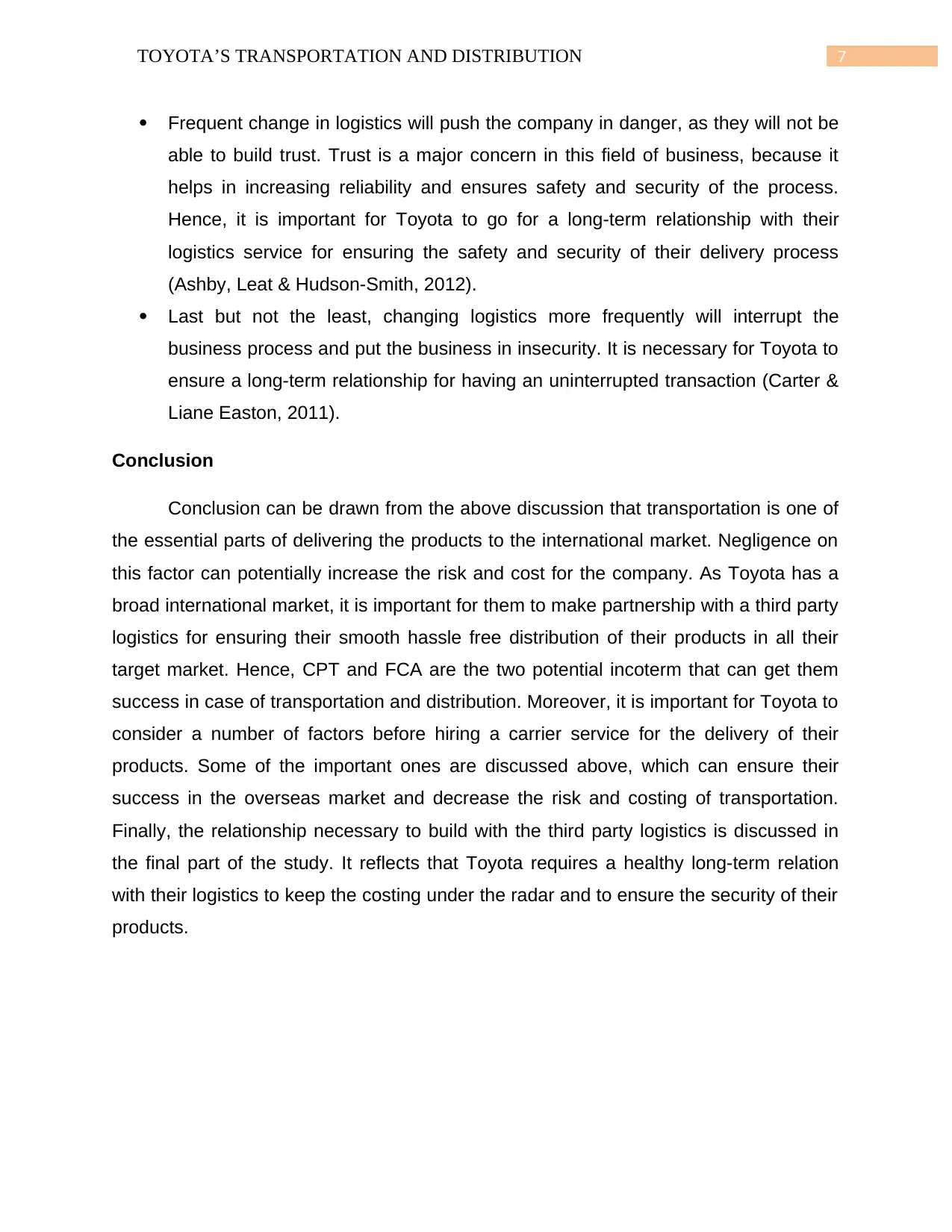
7TOYOTA’S TRANSPORTATION AND DISTRIBUTION
Frequent change in logistics will push the company in danger, as they will not be
able to build trust. Trust is a major concern in this field of business, because it
helps in increasing reliability and ensures safety and security of the process.
Hence, it is important for Toyota to go for a long-term relationship with their
logistics service for ensuring the safety and security of their delivery process
(Ashby, Leat & Hudson-Smith, 2012).
Last but not the least, changing logistics more frequently will interrupt the
business process and put the business in insecurity. It is necessary for Toyota to
ensure a long-term relationship for having an uninterrupted transaction (Carter &
Liane Easton, 2011).
Conclusion
Conclusion can be drawn from the above discussion that transportation is one of
the essential parts of delivering the products to the international market. Negligence on
this factor can potentially increase the risk and cost for the company. As Toyota has a
broad international market, it is important for them to make partnership with a third party
logistics for ensuring their smooth hassle free distribution of their products in all their
target market. Hence, CPT and FCA are the two potential incoterm that can get them
success in case of transportation and distribution. Moreover, it is important for Toyota to
consider a number of factors before hiring a carrier service for the delivery of their
products. Some of the important ones are discussed above, which can ensure their
success in the overseas market and decrease the risk and costing of transportation.
Finally, the relationship necessary to build with the third party logistics is discussed in
the final part of the study. It reflects that Toyota requires a healthy long-term relation
with their logistics to keep the costing under the radar and to ensure the security of their
products.
Frequent change in logistics will push the company in danger, as they will not be
able to build trust. Trust is a major concern in this field of business, because it
helps in increasing reliability and ensures safety and security of the process.
Hence, it is important for Toyota to go for a long-term relationship with their
logistics service for ensuring the safety and security of their delivery process
(Ashby, Leat & Hudson-Smith, 2012).
Last but not the least, changing logistics more frequently will interrupt the
business process and put the business in insecurity. It is necessary for Toyota to
ensure a long-term relationship for having an uninterrupted transaction (Carter &
Liane Easton, 2011).
Conclusion
Conclusion can be drawn from the above discussion that transportation is one of
the essential parts of delivering the products to the international market. Negligence on
this factor can potentially increase the risk and cost for the company. As Toyota has a
broad international market, it is important for them to make partnership with a third party
logistics for ensuring their smooth hassle free distribution of their products in all their
target market. Hence, CPT and FCA are the two potential incoterm that can get them
success in case of transportation and distribution. Moreover, it is important for Toyota to
consider a number of factors before hiring a carrier service for the delivery of their
products. Some of the important ones are discussed above, which can ensure their
success in the overseas market and decrease the risk and costing of transportation.
Finally, the relationship necessary to build with the third party logistics is discussed in
the final part of the study. It reflects that Toyota requires a healthy long-term relation
with their logistics to keep the costing under the radar and to ensure the security of their
products.
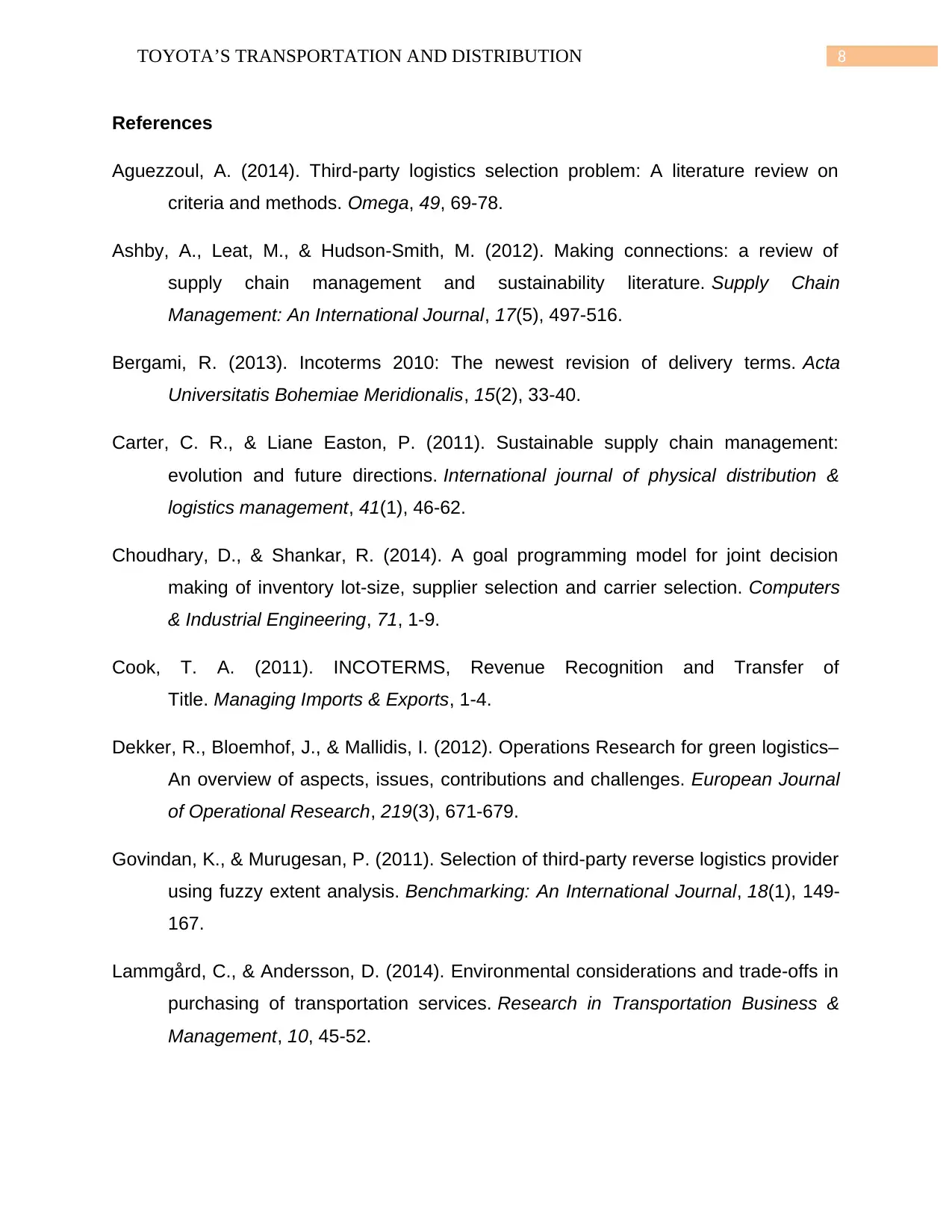
8TOYOTA’S TRANSPORTATION AND DISTRIBUTION
References
Aguezzoul, A. (2014). Third-party logistics selection problem: A literature review on
criteria and methods. Omega, 49, 69-78.
Ashby, A., Leat, M., & Hudson-Smith, M. (2012). Making connections: a review of
supply chain management and sustainability literature. Supply Chain
Management: An International Journal, 17(5), 497-516.
Bergami, R. (2013). Incoterms 2010: The newest revision of delivery terms. Acta
Universitatis Bohemiae Meridionalis, 15(2), 33-40.
Carter, C. R., & Liane Easton, P. (2011). Sustainable supply chain management:
evolution and future directions. International journal of physical distribution &
logistics management, 41(1), 46-62.
Choudhary, D., & Shankar, R. (2014). A goal programming model for joint decision
making of inventory lot-size, supplier selection and carrier selection. Computers
& Industrial Engineering, 71, 1-9.
Cook, T. A. (2011). INCOTERMS, Revenue Recognition and Transfer of
Title. Managing Imports & Exports, 1-4.
Dekker, R., Bloemhof, J., & Mallidis, I. (2012). Operations Research for green logistics–
An overview of aspects, issues, contributions and challenges. European Journal
of Operational Research, 219(3), 671-679.
Govindan, K., & Murugesan, P. (2011). Selection of third-party reverse logistics provider
using fuzzy extent analysis. Benchmarking: An International Journal, 18(1), 149-
167.
Lammgård, C., & Andersson, D. (2014). Environmental considerations and trade-offs in
purchasing of transportation services. Research in Transportation Business &
Management, 10, 45-52.
References
Aguezzoul, A. (2014). Third-party logistics selection problem: A literature review on
criteria and methods. Omega, 49, 69-78.
Ashby, A., Leat, M., & Hudson-Smith, M. (2012). Making connections: a review of
supply chain management and sustainability literature. Supply Chain
Management: An International Journal, 17(5), 497-516.
Bergami, R. (2013). Incoterms 2010: The newest revision of delivery terms. Acta
Universitatis Bohemiae Meridionalis, 15(2), 33-40.
Carter, C. R., & Liane Easton, P. (2011). Sustainable supply chain management:
evolution and future directions. International journal of physical distribution &
logistics management, 41(1), 46-62.
Choudhary, D., & Shankar, R. (2014). A goal programming model for joint decision
making of inventory lot-size, supplier selection and carrier selection. Computers
& Industrial Engineering, 71, 1-9.
Cook, T. A. (2011). INCOTERMS, Revenue Recognition and Transfer of
Title. Managing Imports & Exports, 1-4.
Dekker, R., Bloemhof, J., & Mallidis, I. (2012). Operations Research for green logistics–
An overview of aspects, issues, contributions and challenges. European Journal
of Operational Research, 219(3), 671-679.
Govindan, K., & Murugesan, P. (2011). Selection of third-party reverse logistics provider
using fuzzy extent analysis. Benchmarking: An International Journal, 18(1), 149-
167.
Lammgård, C., & Andersson, D. (2014). Environmental considerations and trade-offs in
purchasing of transportation services. Research in Transportation Business &
Management, 10, 45-52.
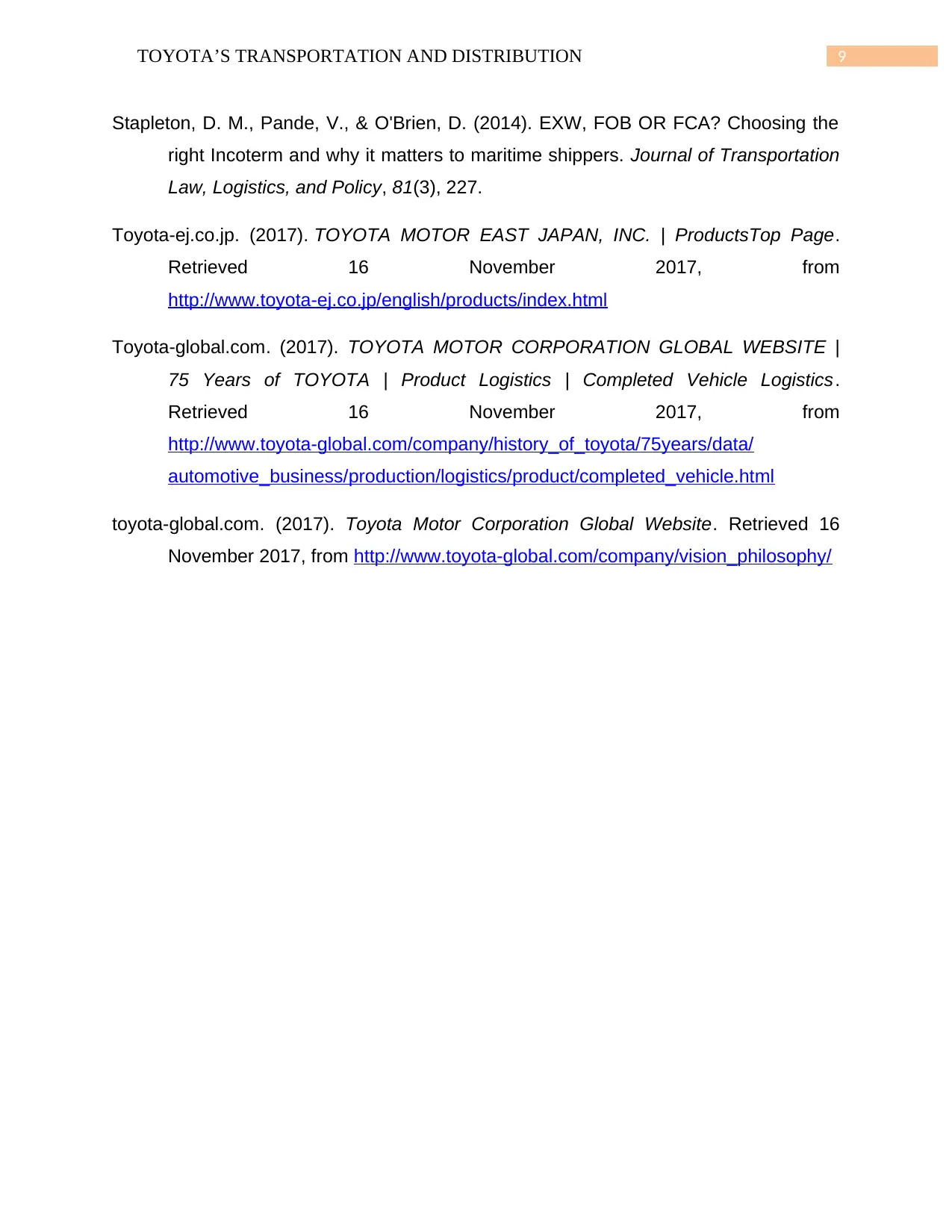
9TOYOTA’S TRANSPORTATION AND DISTRIBUTION
Stapleton, D. M., Pande, V., & O'Brien, D. (2014). EXW, FOB OR FCA? Choosing the
right Incoterm and why it matters to maritime shippers. Journal of Transportation
Law, Logistics, and Policy, 81(3), 227.
Toyota-ej.co.jp. (2017). TOYOTA MOTOR EAST JAPAN, INC. | ProductsTop Page.
Retrieved 16 November 2017, from
http://www.toyota-ej.co.jp/english/products/index.html
Toyota-global.com. (2017). TOYOTA MOTOR CORPORATION GLOBAL WEBSITE |
75 Years of TOYOTA | Product Logistics | Completed Vehicle Logistics.
Retrieved 16 November 2017, from
http://www.toyota-global.com/company/history_of_toyota/75years/data/
automotive_business/production/logistics/product/completed_vehicle.html
toyota-global.com. (2017). Toyota Motor Corporation Global Website. Retrieved 16
November 2017, from http://www.toyota-global.com/company/vision_philosophy/
Stapleton, D. M., Pande, V., & O'Brien, D. (2014). EXW, FOB OR FCA? Choosing the
right Incoterm and why it matters to maritime shippers. Journal of Transportation
Law, Logistics, and Policy, 81(3), 227.
Toyota-ej.co.jp. (2017). TOYOTA MOTOR EAST JAPAN, INC. | ProductsTop Page.
Retrieved 16 November 2017, from
http://www.toyota-ej.co.jp/english/products/index.html
Toyota-global.com. (2017). TOYOTA MOTOR CORPORATION GLOBAL WEBSITE |
75 Years of TOYOTA | Product Logistics | Completed Vehicle Logistics.
Retrieved 16 November 2017, from
http://www.toyota-global.com/company/history_of_toyota/75years/data/
automotive_business/production/logistics/product/completed_vehicle.html
toyota-global.com. (2017). Toyota Motor Corporation Global Website. Retrieved 16
November 2017, from http://www.toyota-global.com/company/vision_philosophy/
1 out of 10
Related Documents
Your All-in-One AI-Powered Toolkit for Academic Success.
+13062052269
info@desklib.com
Available 24*7 on WhatsApp / Email
![[object Object]](/_next/static/media/star-bottom.7253800d.svg)
Unlock your academic potential
© 2024 | Zucol Services PVT LTD | All rights reserved.





